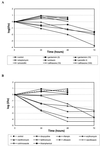Bactericidal activities of antibiotics against intracellular Francisella tularensis
- PMID: 11083651
- PMCID: PMC90216
- DOI: 10.1128/AAC.44.12.3428-3431.2000
Bactericidal activities of antibiotics against intracellular Francisella tularensis
Abstract
MICs of many antibiotics for Francisella tularensis are low in axenic medium, whereas only aminoglycosides, tetracyclines, and fluoroquinolones are useful in treating tularemic patients. In an in vitro cell system, only these antibiotics, rifampin, and telithromycin were bactericidal against intracellular F. tularensis. These results correlate better with clinical data than MIC data do.
Figures

References
-
- Bhatnagar N, Getachew E, Straley S, Williams J, Meltzer M, Fortier A. Reduced virulence of rifampicin-resistant mutants of Francisella tularensis. J Infect Dis. 1994;170:841–847. - PubMed
-
- Cross J T, Jacobs R F. Tularemia: treatment failures with outpatient use of ceftriaxone. Clin Infect Dis. 1993;17:976–980. - PubMed
-
- Cross J T J, Schutze G E, Jacobs R F. Treatment of tularemia with gentamicin in pediatric patients. Pediatr Infect Dis J. 1995;14:151–152. - PubMed
MeSH terms
Substances
LinkOut - more resources
Full Text Sources
Other Literature Sources
Medical

